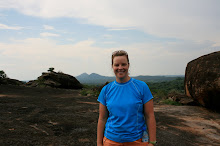
We arrived safely into Entebbe, Uganda on Monday morning. Only one of us had her luggage not make it, which is a nice record for British Airways. Fortunately for me, my luggage arrived. We piled our luggage into the coaster and made our way to Kampala, the capitol. I felt like I have not left. Things look the same; maybe there is more growth, but it is still a beautiful country.
Once in Kampala, we headed to Backpacker’s Hostel to unload and get into our rooms. We had some time, so I took a shower. Although it was cold, it was heaven after traveling in the same clothes for two days. Putting on clean clothes made all of the difference in the world. We then headed to Garden City to change money and pick up supplies. Uganda has created new bills, and they are so pretty. It’s like playing with Monopoly money, which makes it easier to spend… not a good thing. The exchange rate is $1= 2200 Ugandan shillings, which is really good for us.
After Garden City, returned to Backpacker’s. The plan was to go visit Lubiri Secondary School; however Catherine, Lindsey and I did not visit since we visited last year. I took a nice long nap, which was fantastic. I felt so much better upon awakening.
For dinner, we ate at Sam’s, an Indian restaurant in Kampala. We got there about 6:00 pm and ate at 8:30 pm. Welcome to Uganda and African time. The food was delicious and worth a wait, but not necessarily 2 ½ hours (really, is any food worth waiting 2 ½ hours? I mean, homemade ice cream doesn’t even take that long!) It was a great meal and a really great opportunity to meet and talk to more of the group. I think we are going to have a great group.
We woke up this morning (Tuesday), packed up and headed to Bavubuka House, an arts house for boys and girls in Kampala. It was started by the world famous Ugandan rapper, Sirus. The boys and girls practice all of the arts, and they are completely free to express themselves. It is such a positive environment for these kids, and they are really talented. They have made many improvements to the compound since we visited last year. They added a wall and gates as well as two murals that are beautiful. They have also increased the amount of girls and the emphasis on empowering women, which I thought was awesome.
We were held up a little on trying to make the trek to Gulu because of Allison’s lost bag. We ended up returning to Garden City to meet her and Amy. We left Kampala at 3:00 pm. The road to Gulu has improved greatly, but it still took forever. We ended up making one short call break and arrived in Gulu at 8:30 pm. It took us a minute to find the house. It is located right behind the Invisible Children office on the Pece side of Gulu. Finding the house in the dark was daunting and after turning the Coaster around a couple of times, we finally found it. It is a pretty good size house, but for housing 19 and then another 13 coming in two weeks, it is cramped. There are two toilets two pit latrines in the backyard, one shower, and one bathtub with a shower nozzle but no shower curtain. The water pressure is terrible, terrible, terrible. The yard is beautiful though and spacious. I am curious to watch the dynamics of the group over the next 6 weeks in this space.








